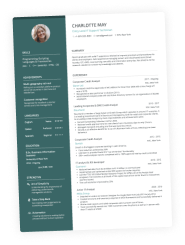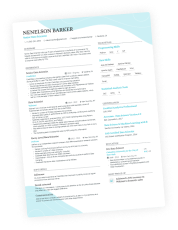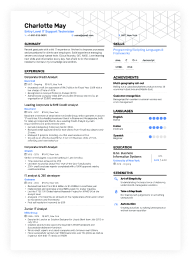Landing your first job as a high school student often feels impossible: you need experience to get hired, but you need a job to gain experience.
Here’s the truth—you already have more to offer than you think. Volunteer work, school projects, club leadership, and even side gigs like babysitting or tutoring can show employers that you’re responsible, motivated, and ready to learn. A well‑crafted high school resume turns these experiences into a professional snapshot that opens doors to part‑time jobs, internships, and scholarships.
In this guide, you’ll learn how to:
- Build a high school resume that works, even with no job experience.
- Turn school and extracurricular activities into impressive bullet points.
- Format your resume to be clear and scannable by applicant tracking systems (ATS)—a habit that’ll pay off in the future, even if ATS isn’t involved yet.
By the end, you’ll have a one‑page resume that helps you take the first step toward your career goals.
Key takeaways
- A high school resume is your one‑page introduction to employers, colleges, and scholarship committees.
- You don’t need job experience—amplify what you have done, whether it’s organizing a school project, volunteering in your community, or leading a team activity.
- Show your potential with impact: use action verbs, add numbers when you can, and keep your strongest achievements in the top third of your resume.
- Show both practical and personal strengths—list technical skills (like software or languages) alongside qualities like communication, teamwork, or leadership.
- Keep it professional: stick to one page, use clean formatting and standard fonts, and always save as a PDF.
- Use words from the job ad when you can—this helps your resume stand out to both people and the software that screens applications.
Use Enhancv’s Resume Checker to analyze your resume and receive personalized suggestions in seconds.
Is your resume good enough?
Drop your resume here or choose a file. PDF & DOCX only. Max 2MB file size.
Step 1. Understand what a high school resume really is
A high school resume isn’t just a list of jobs—it’s your personal introduction to opportunities.
Think of it as a one-page snapshot that shows employers, colleges, or scholarship committees three things:
- Who you are.
- What you’ve done.
- What you’re capable of doing next.
For most first-time job seekers, that means your resume won’t focus on years of paid work. Instead, it highlights transferable experiences—school projects, volunteer roles, extracurricular activities, and skills you’ve already developed in everyday life.
Your high school resume doesn’t need to look complicated. Clarity and relevance matter more than fancy design—save the creativity for your bullet points and examples.
Step 2. What to put on your resume if you have no work experience
No job history? No problem.A strong high school resume focuses on what you’ve already done—whether that’s in school, your community, or at home.
Start with the key sections every high school resume should include:
- A short objective that outlines your goals and what you can offer.
- Your education, including your school name, expected graduation date, and GPA (if it’s 3.0 or higher).
- Any relevant experience—volunteering, school projects, extracurriculars, or side gigs.
- A list of your skills that shows both practical abilities and personal strengths.
Once you’ve built that structure, fill your experience section with the activities that show your initiative and reliability.
Here are four types of experience that work perfectly for a high school resume:
Volunteer work
- Food drives, charity events, or community projects.
- Shows you’re reliable and community‑minded.
- •Organized weekly food drives serving 200+ families.
- •Trained 5 new volunteers on donation intake procedures.
Extracurricular activities and leadership
- Sports teams, clubs, student government, band, and debate.
- Highlight leadership or commitment (team captain, treasurer, section leader).
- •Managed an annual budget of $2,000 for school events and fundraisers.
- •Organized and promoted 3 student-led events with 100+ attendees each.
- •Coordinated a team of 8 peers to execute community service projects.
School or personal projects
- Fundraisers, science fair entries, coding apps, and video production projects.
- Emphasize results: raised money, built something, or achieved recognition.
- •Designed and built a solar-powered water pump prototype for sustainable irrigation.
- •Presented findings to 5 faculty judges and earned 2nd place in the regional science fair.
- •Collaborated with a team of 3 classmates to document and analyze energy output efficiency.
Side gigs and family contributions
- Babysitting, lawn care, tutoring, and helping with a family business.
- Counts as work experience if you had responsibilities and measurable outcomes.
- •Supervise and care for two children (ages 3 and 6) three evenings per week.
- •Prepare meals, assist with homework, and manage bedtime routines.
- •Built trust with parents, maintaining a 100% on‑time attendance record.
PRO TIP
Quantify whenever possible—numbers make your experience tangible. “Tutored three students weekly, improving grades by an average of 15%” leaves a stronger impression than “Tutored students.”
Step 3. Skills that make teen resumes stand out
Your skills section is where you prove what you can do, even without a formal job. For high school students, this is often a mix of hard skills (technical or teachable abilities) and soft skills (personal and interpersonal strengths). Both can make a difference if they’re presented the right way.
Start with your hard skills—things you’ve learned or used that could be useful in a job or internship.
Here’s how you might list them on your resume:
Skills
Microsoft Word & Google Docs · Canva & basic graphic design · Conversational Spanish · Typing: 75 WPM
Best hard skills for your high school resume
- Microsoft Office (Word, Excel, PowerPoint) or Google Workspace
- Social media management or content creation
- Coding basics (HTML, Python, Scratch)
- Typing speed, graphic design tools, or video editing
- Foreign languages or certifications (CPR, food handler card)
Soft skills—like teamwork, organization, or communication—are better shown in your bullet points, not just listed in a skills section.
Bullet point example
Coordinated a group fundraiser that raised $300 in one day—managed volunteers and handled event promotion.
This tells an employer that you're organized, dependable, and know how to lead—all without ever using those words directly.
If you do list soft skills, use a few that match the tone of the opportunity. Just be sure you’re backing them up elsewhere in your resume.
Best soft skills for your high school resume
- Communication and active listening
- Teamwork and leadership
- Organization and time management
- Reliability and strong work ethic
- Problem-solving and adaptability
Step 4. Formatting rules for a polished, professional look
Even the best experience can get overlooked if your resume is hard to read. Employers spend only a few seconds scanning each resume, so a clean, consistent format makes your application feel professional and easy to navigate.
Follow these key formatting rules:
- Keep it to one page: High school resumes rarely need more than a single page.
- Use clear margins and fonts: 0.7 to 1 inch margins and fonts like Rubik, Arial, or Lato.
- Size matters: Your name 16 to 18 pt, section titles 12 to 14 pt, content 10 to 12 pt.
- Rely on bullet points: They make accomplishments easier to scan than full sentences.
- Use a clean, professional design: Subtle colors or simple layouts are fine, but avoid overly decorative fonts or distracting graphics.
- Save as PDF: After editing your resume, export it as a PDF so your layout stays consistent on any device.
Before sending, print or preview your resume to ensure spacing and alignment look neat. A resume that’s easy to read is far more likely to make a strong first impression.
Step 5. How to turn your experience into strong resume entries
You don’t need a long job history to create a compelling resume. What matters is how you frame your background. Whether it’s a part-time job, a volunteer role, or a school project, you can shape your experience into something that feels professional and impactful.
Below are three real-life examples that show how high school students have turned limited experience into strong resume sections—each one tailored for a different goal:
Applying for your first job (retail or fast food)
- •Greeted 50+ customers per shift and maintained a clean dining area.
- •Learned to operate POS system and handle cash transactions accurately.
- •Worked flexible hours while maintaining a 3.5 GPA in school.
Looking for an internship or volunteer opportunity
- •Assisted visitors with book check-outs and catalog searches.
- •Coordinated weekend children's reading events with 30+ attendees.
- •Organized shelves and improved book tracking efficiency.
Applying for college or a scholarship
- •Designed and presented a solar-powered water pump prototype.
- •Earned 2nd place at the regional science fair for sustainable design.
- •Collaborated with 3 teammates to collect and analyze energy data.
Once you’ve drafted your resume, consider applying your content to a simple professional template using Word, Google Docs, or Enhancv’s resume builder. Design should support your story—not distract from it.
Conclusion
Your first resume is more than a list of activities—it’s a snapshot of your potential. By turning volunteer work, school projects, and side gigs into professional bullet points, you show employers and scholarship committees that you’re responsible, motivated, and ready to contribute.
Every job, internship, or scholarship you apply for is an opportunity to practice telling your story. Starting early gives you an edge over other first‑time job seekers and sets you up for future success.
You’ve already done the hard part—now turn those experiences into a resume that truly reflects who you are.
Make one that's truly you.



